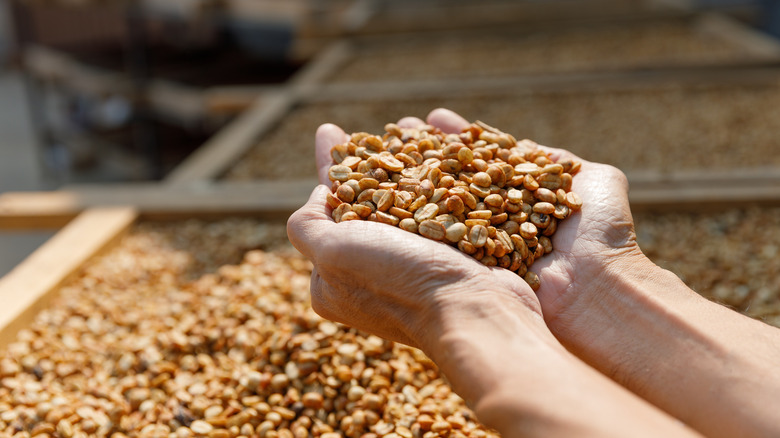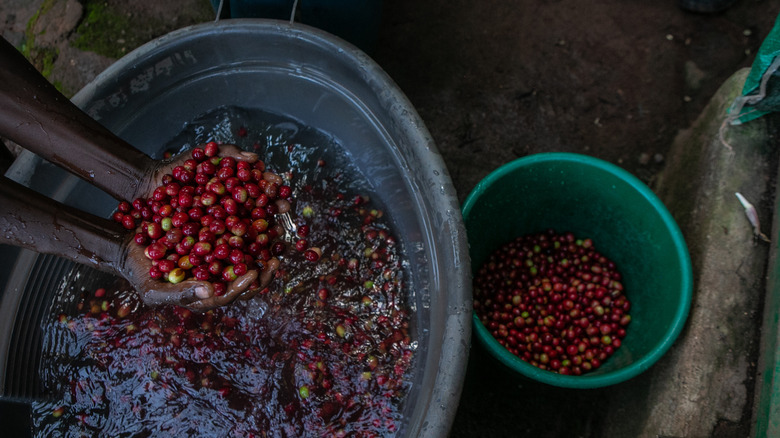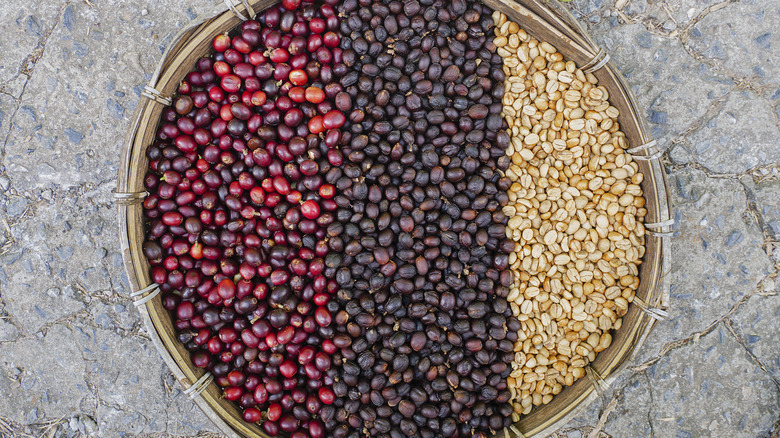What Makes Honey Process Coffee Unique?
Most coffee lovers know the heart-and-hand-warming cup of java they cradle every morning comes from roasted beans, available in either whole bean or ground versions for spooning into a drip, French press, stovetop, or pod machine. It's a rite of passage into every new day, at least for most caffeine devotees. But there's a whole invisible process that occurs before the beans even get roasted, one that's as intricate and nuanced as the flavor profiles we crave. "Bean to cup" is more than a catchphrase displayed across coffee-shop signage – and the steps just after plucking the coffee "cherries" are often where the flavor is born.
From traditional dry processing in countries such as Ethiopia to the vastly more common wet process, coffee cherries become the beans we know and love, explains the Paulig Barista Institute. But there's a third option for prepping those freshly harvested treasures for their journey to your cup. It's called honey processing, and actual honey isn't even remotely involved. Instead, this coffee processing method gets its name from three of the beloved traits of genuine honey: the color, the sweetness, and, yes, the glorious sticky texture.
Sweet, sticky success
No bees get credit for honey process coffee, and the stickiness involved comes from an inherent component of coffee cherries — the mucilage coating found between the outer pulp and the actual cherry (which eventually becomes what we know as a coffee bean), explains Coffee Affection. Because of its gooey nature and yellow hue, the mucilage is often referred to as "honey." As the coating ferments, the bean absorbs sweetness, and the longer it ferments, the sweeter and fruitier it gets.
The honey process differs from the other two techniques in several ways. In traditional dry processing, also known as the natural method, the outer shells, mucilage coatings, and inner cherries remain intact until they dry naturally in the sun. This produces complex flavors that true coffee lovers crave. However, the lengthy process and lack of consistency make it difficult for coffee purveyors to market specific flavor profiles to customers. Instead, many turn to wet or "washed" processing.
As the name indicates, washed beans go through a water bath to remove the outer skin and pulp, get dunked in water tanks, and enter fermentation, according to Patriot Craft Coffee. In this stage, the mucilage coating dissipates, and the natural bean sugars convert to acids or sometimes alcohol — which accounts for wine-like notes in some coffees. Then comes another water rinse and a bit of time sunbathing before the bevy of smooth, uniform beans emerge for a long-distance journey to roasters and coffee cups across the continents.
Yellow, red, and black honey processing
If you thought coffee processing couldn't get more detailed, here's a deeper dive that differentiates flavors by the changing colors of a bean. It only happens with honey coffee processing, and it revolves around ever-deepening hues of yellow, red, and black. The hues evolve over time as the cherries ferment; the longer they're allowed to ferment, the deeper and richer the colors, which ultimately affects the flavors, per Coffee Affection.
Color changes come from oxidation of the sticky mucilage coating, explains Trianon Coffee, which is why it only happens in honey processing. Generally, time determines the change from yellow to red and, finally, to black. But intervention by the farmer/processor can also affect coloring and taste. In yellow honey processing, frequent turning of the beans makes them dry more quickly, and the reduced time lessens fruit-forward flavors. The longer stage, red honey processing, leads to increasingly sweeter beans, followed by black honey processing for the fruitiest of the three stages.
Origin Coffee goes even deeper into honey processing by noting differences in the amount of mucilage left on the bean, with yellow having 50% removed, red losing 25%, and black retaining all of its original sticky coating. Origin also adds two more subtle divergences in the yellow category: golden and white honey processing.


